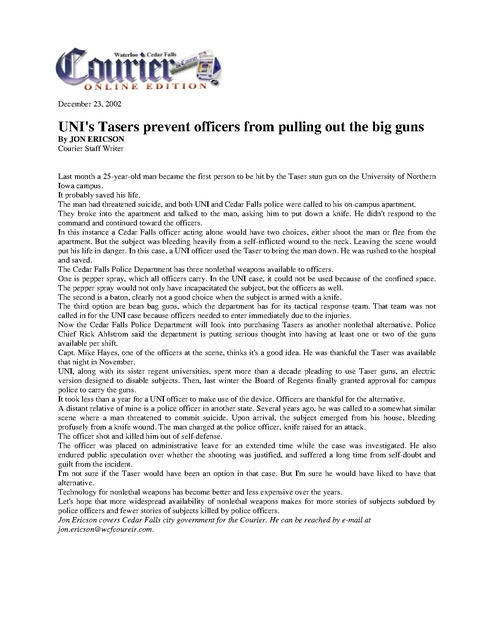Taser Uni Taser Saves Life 2002
Download original document:

Document text

Document text
This text is machine-read, and may contain errors. Check the original document to verify accuracy.
December 23, 2002 UNI's Tasers prevent officers from pulling out the big guns By JON ERICSON Courier Staff Writer Last month a 25-year-old man became the first person to be hit by the Taser stun gun on the University of Northern Iowa campus. It probably saved his life. The man had threatened suicide, and both UNI and Cedar Falls police were called to his on-campus apartment. They broke into the apartment and talked to the man, asking him to put down a knife. He didn't respond to the command and continued toward the officers. In this instance a Cedar Falls officer acting alone would have two choices, either shoot the man or flee from the apartment. But the subject was bleeding heavily from a self-inflicted wound to the neck. Leaving the scene would put his life in danger. In this case, a UNI officer used the Taser to bring the man down. He was rushed to the hospital and saved. The Cedar Falls Police Department has three nonlethal weapons available to officers. One is pepper spray, which all officers carry. In the UNI case, it could not be used because of the confined space. The pepper spray would not only have incapacitated the subject, but the officers as well. The second is a baton, clearly not a good choice when the subject is armed with a knife. The third option are bean bag guns, which the department has for its tactical response team. That team was not called in for the UNI case because officers needed to enter immediately due to the injuries. Now the Cedar Falls Police Department will look into purchasing Tasers as another nonlethal alternative. Police Chief Rick Ahlstrom said the department is putting serious thought into having at least one or two of the guns available per shift. Capt. Mike Hayes, one of the officers at the scene, thinks it's a good idea. He was thankful the Taser was available that night in November. UNI, along with its sister regent universities, spent more than a decade pleading to use Taser guns, an electric version designed to disable subjects. Then, last winter the Board of Regents finally granted approval for campus police to carry the guns. It took less than a year for a UNI officer to make use of the device. Officers are thankful for the alternative. A distant relative of mine is a police officer in another state. Several years ago, he was called to a somewhat similar scene where a man threatened to commit suicide. Upon arrival, the subject emerged from his house, bleeding profusely from a knife wound. The man charged at the police officer, knife raised for an attack. The officer shot and killed him out of self-defense. The officer was placed on administrative leave for an extended time while the case was investigated. He also endured public speculation over whether the shooting was justified, and suffered a long time from self-doubt and guilt from the incident. I'm not sure if the Taser would have been an option in that case. But I'm sure he would have liked to have that alternative. Technology for nonlethal weapons has become better and less expensive over the years. Let's hope that more widespread availability of nonlethal weapons makes for more stories of subjects subdued by police officers and fewer stories of subjects killed by police officers. Jon Ericson covers Cedar Falls city government for the Courier. He can be reached by e-mail at jon.ericson@wcfcoureir.com.

